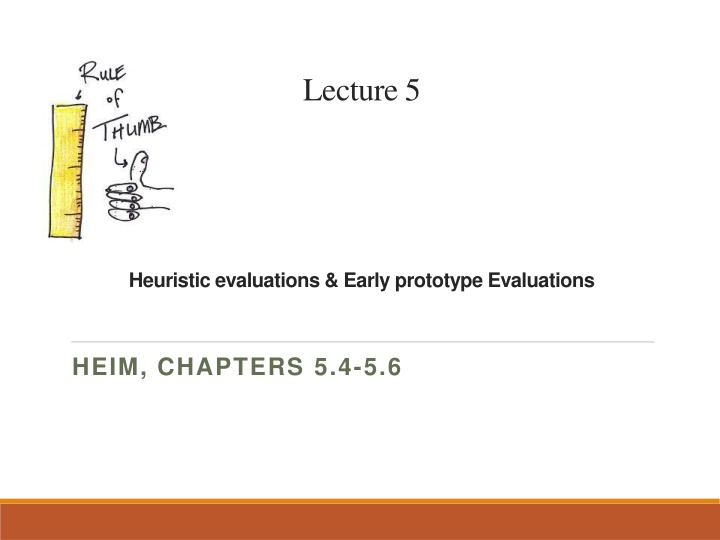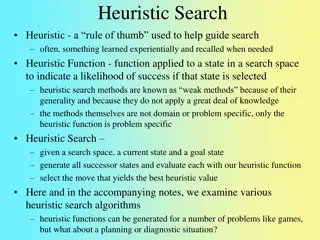
Heuristic Evaluations and Early Prototypes in Usability Testing
Explore the importance of heuristic evaluations and early prototypes in usability testing, focusing on Nielsen's heuristics and evaluation challenges. Understand how experts assess system usability, determine predicted, false, missed, and actual problems, and the value of heuristic evaluation in study design. Get insights into Nielsens Heuristics and how they aid in interface design, ensuring visibility, matching real-world scenarios, user control, error prevention, and more.
Download Presentation

Please find below an Image/Link to download the presentation.
The content on the website is provided AS IS for your information and personal use only. It may not be sold, licensed, or shared on other websites without obtaining consent from the author. If you encounter any issues during the download, it is possible that the publisher has removed the file from their server.
You are allowed to download the files provided on this website for personal or commercial use, subject to the condition that they are used lawfully. All files are the property of their respective owners.
The content on the website is provided AS IS for your information and personal use only. It may not be sold, licensed, or shared on other websites without obtaining consent from the author.
E N D
Presentation Transcript
Lecture 5 Heuristic evaluations & Early prototype Evaluations HEIM, CHAPTERS 5.4-5.6
Learning objectives To be aware of a range of heuristic evaluation options appropriate to the analysis and design phase In particular well known heuristics of usable systems Nielsen s heuristics Schneiderman s rules To understand the difference evaluation challenges of early prototypes with limited functionality Be aware of the requirements for assignment 1
Heuristic evaluations Expert evaluation An expert looks at a system using common sense and/ or guidelines (e.g. Nielsen s Heuristics) Expert - reviewer First law of usability: Heuristic evaluation has only 50% hit-rate Predicted problems False problems Missed problems Actual problems More http://www.upassoc.org/upa_publications/jus/2008november/JUS_Kirmani_Nov2008.pdf Usability Evaluations 3
Evaluation Heuristic Evaluation Heuristic evaluations are performed by usability experts using a predetermined set of criteria designed to measure the usability of a proposed design. The evaluator follows a scenario through the design and tests each step against the heuristic criteria. Carrying out a heuristic evaluation is an excellent way to get an understanding of a system that you are going to usability test . But be careful, it can prejudice your study design Or a heuristic evaluation can be stand-alone with the evaluator making observations and recommendations based on their experience.
Evaluation Nielsens Heuristics In collaboration with Rolf Molich, Jakob Nielsen developed a set of 10 heuristics for interface design. The revised set based on an analysis of 249 usability problems. http://www.useit.com/papers/heuristic/heuristic_list.html
Nielsens Heuristics 1. Visibility of System Status 2. Match between System and the Real World 3. User Control and Freedom 4. Consistency and Standards 5. Error Prevention 6. Recognition Rather Than Recall 7. Flexibility and Efficiency of Use 8. Aesthetic and Minimalist Design 9. Help Users to Recognise, Diagnose, and Recover from Errors 10. Help and Documentation Usability Evaluations 6
Nielsens heuristic #2 Does the vocabulary match the user s expectations and knowledge? Are you calling the objects on the screen by terms that the user understands (and finds natural)? E.g. student # or user id or UPI Does the workflow match the task? Will the user have all the required information at the time I am asking? Are they copying from a paper source that lays out the material differently than my data input screen? Am I making them stop in the middle of a task they d rather not interrupt? Usability Evaluations 7
Nielsen heuristic #6 If I can put the item on a dropdown list, then I should Why make them type it in and maybe choose an option that s not available? Show the user something Maybe you ll get lucky and it ll be just what they want! E.g. I hate a search that makes me specify whether I want those options available starting with A or B etc. (or even worse, just a blank) You can give me shortcuts to those, but have an alphabetic list visible (maybe have most frequent, or last selected options at very top!) Basically, use menus and lists instead of relying on blanks Usability Evaluations 8
Nielsens Advice for Heuristic Evaluations Use multiple independent evaluators Use an observer to record evaluator Go through the interface several times Compare interaction against list of heuristics Use heuristics specific to design List heuristic problems and how the heuristic is violated In assignment 1, we have you heuristically evaluate the interface
Shneidermans 8 Golden Rules 1. Strive for consistency E.g. exact same terms for objects, same command syntax throughout 2. Enable frequent users to use shortcuts 3. Offer informative feedback 4. Design dialogs to yield closure 5. Offer error prevention and simple error handling 6. Permit easy reversal of actions 7. Support internal locus of control Make users initiators rather than responders (e.g. direct manipulation!) 8. Reduce short-term memory load What the user needs to know should be readily visible
A world of heuristics Can be devised for more specific domains For physical format e.g. web pages http://www.psu.edu/webconference/Web2004/Materials/Heuristic.pdf Domain specific concepts like good background graphics Housekeeping like correct spelling & grammar May want to evaluate the search function For task domain e.g. in health Is patient name and date-of-birth clearly visible at all times? Does the interaction fit to clinical workflow? Can be quite long About 100 heuristics for mobile apps: www.tmap.net/sites/tmap.../Checklist_Mobile_App_Testing_0.docx
Evaluating Prototypes Evaluating early prototypes is a bit different to evaluating fully functional systems because of the lack or limited functionality. The system could just be a block of wood with some dials drawn on it! Or could be a semi functional prototype in a prototyping environment or UI design tool
Half time distraction Pay no attention to that man behind the curtain www.youtube.com/watch?v=YWyCCJ6B2WE
Wizard of Oz prototype evaluation Can make a functional prototype where a key function is performed by a human, Wizard of Oz This was done for early testing of speech-to-text interfaces (a listening typewriter ) The speech-to-text function was implemented by a good [human] typist! Great for testing usability of systems with an AI before the AI is implemented E.g. in some types of video games The less realistic the prototype the more creative user feedback you will receive So really good for disruptive technologies.
Functional prototypes Functional prototypes are interactive prototypes that represent various degrees of functionality Functioning prototypes can be created using Prototyping tools ( eg Balsamiq see next slide) Or RAD environments, such as: Microsoft Visual Studio Adobe Flash Dreamweaver Director
Prototyping tools Advantage Closer to the real interface and can explore the functionality a bit more Disadvantage Lock down the design, therefore inhibit creativity Balsamiq Visual Studio
Assignment 1 The purpose of assignment 1 is to get you to DO some of this. Your job is to analyse a UI and then plan a usability test for parking meters on Princes St. STN of the interface. Heuristic evaluation of the interface Plan a usability test (we will cover this in the next couple of lectures). Full specification https://www.cs.auckland.ac.nz/courses/compsci34 5s1c/assignments/ Due Sunday 22 March 2014 https://adb.auckland.ac.nz/
Summary Heuristic evaluations are Expert reviews and often include Modelling the interface (eg HTA) Evaluating against a set of guidelines . . Early prototype evaluations vary from functional systems evaluations depending on the stage of development and amount of functionality provided. Assignment 1 requires you to undertake a heuristic evaluation and plan a usability test






















